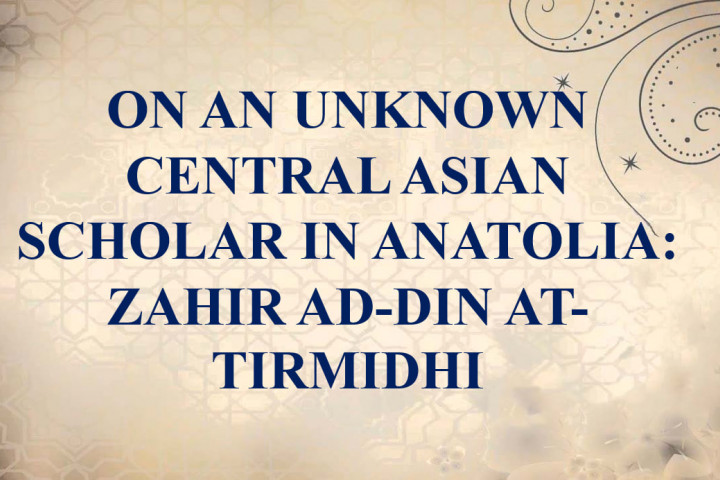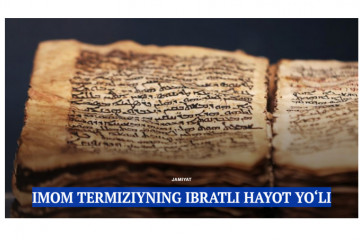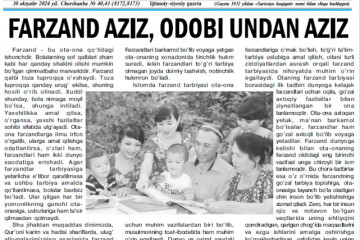
ON AN UNKNOWN CENTRAL ASIAN SCHOLAR IN ANATOLIA: ZAHIR AD-DIN AT-TIRMIDHI
For world science, the study of the legacy of the Hanafite scholars of Central Asia is of great importance, along with the scholars of this region. Local jurists are also recognized in other regions of the Islamic world. This, in turn, indicates the need for a serious approach to the study of the emergence, stages, directions, peculiarities and traditions of the science of jurisprudence in the region.
In this regard, it is possible to point out the activities of Termez faqihs, the history of the development of the Hanafite school in the south of Uzbekistan and some complex works devoted to its study. One of the most pressing issues in this sphere is to study the life, work of Zahir ad-Din at-Tirmidhi and the period in which the scholar lived.
It was not possible to find information about the scholar in the known Hanafi biographical sources. The only historical source in which the name Zahir ad-Din is mentioned is the work of Saljuqnama:
“When Kayhusrev ((1192-1196, 1205-1211) came to Konya and sat on the throne, he did something that no one liked: executed Qadi Tirmidhi, known for his asceticism, piety, correct fatwa and trueworthy, and regarded by the people as the second Abu-l-Layth as-Samarqandi. The reason for this was as follows:
The Sultan had difficulty in capturing the city of Konya, which was due to the fact that the population defended the city vigorously. A group of people who were hostile to the judge and jealous of his reputation among the people distorted the cause of the incident to the sultan and interpreted it differently. According to their false fabrication, the judge had prepared a fatwa against the sultan and the people had refused to submit to the sultan as a result of this fatwa. The text of the fatwa was as follows: “It is not permissible for Sultan Kayhusrev to sit on the throne because he befriended the disbelievers and did what the Shariʼah forbade in the areas they ruled.” The Sultan was furious when he heard this news and ordered the qadi to be executed.
Due to the unjust bloodshed of the judge, the people of Konya could not reap the seeds and crops they had sown for three years. Many people also died due to natural disasters such as cold, hail and snow that came prematurely. Shortly after the judgeʼs death, the sultan punished the slanderers, knowing that what the malicious men said was slander. But in spite of this, the sultanʼs conscience began to gnaw at him incessantly, and he fell into a state of grief. He strongly apologized to the judgeʼs students and children. In addition, he tried to win their hearts by gifting them with iqta and other property to the best of his ability. Eventually, this tragedy and catastrophe disappeared.” [1, р. 115].
As mentioned above, we did not find any information about the judge in the biographical sources. The only study in which the name of this historical figure is mentioned is Abdulsattar Elhajhamedʼs article entitled “Ibn Arabi in Arabic and Turkish Novels: Comparative Study Between Jabal Qaf and Zidyar Al Andalusi”. In his article, the author has taken a slightly different approach to the interpretation of the events in the Konya region. According to the researcher, in Konya, the population revolted against Sultan Giyas ad-din Keyhusrav and he was forced to flee to Constantinople. His adviser, Ishaq al-Rumi, fled to Damascus. Some time later, Giyas ad-din managed to return to Konya and ascend the throne for the second time. Then he sent for Ishaq to return to the city. The city judge had previously issued a fatwa questioning the legitimacy of the sultanʼs authority. The sultan executed him because the judge did not back down from his earlier fatwa. He was replaced by Judge Ishaq al-Rumi, who was sent to the caliph to comment on Tirmidhiʼs assassination.” [2, р. 8].
The sources do not cover Rumiʼs later life and the attitude of the townspeople towards his activities. However, we know that his wife was married by his friend famous Ibn Arabi (d. 638/1240) after his death.
Historical sources also tell us that Ishaq ar-Rumi is no one else but the father of the famous Ottoman Turkish mystic Sadreddin Konevî (d. 673/1274). Konevî is considered to be the second person to present pantheism (wahdat al-wujud) after Ibn al-Arabi. Ekrem Demirli, who wrote an entry to the Turkish Encyclopaedia of Islam, gives the following information on the relation between the two Sufis:
“Using the opportunities of his family, Konevî took lessons from the important teachers of the period and received a good education in the field of religious and philosophical sciences. The most important legacy his father left him was his friendship with scholars and sufis. Among them, the leading name was Muhyiddin Ibn al-Arabi. Ibn al-Arabi came to Malatya through Damascus, Urfa and Diyarbakir upon the invitation of Mecduddin Ishaq, whom he met in Mecca, and stayed with him for a while. From this period on, the friendship between Ibn al-Arabi and Mecduddin had strengthened and turned into a solid friendship. When Mecduddin went to Konya with a mission referred to as the education of the sultanʼs children in legends, İbnüʼl-Arabi went to Konya with him or after a while. It is understood that Ibn al-Arabi gained a high reputation before the Seljuk Palace and established important friendships thanks to the relations of Mecdiddin. As a matter of fact, it is known that he was in close contact with Seljuk sultans and corresponded with them. These relations had important effects on the life and intellectual development of Konevî. Konevîʼs relations with senior executives and scholars in Konya, where he would later settle, were probably a continuation of these relations that started with his father and Ibn al-Arabi.
Sadreddin Konevî lost his father when he was nine or ten years old. It is rumored that upon the death of Mecduddin, Ibn al-Arabi married his widow and became the stepfather of Konevî. It is difficult to determine whether this marriage happened or not. However, the relationship between Ibn al-Arabi and Qunawi continued until Ibn al-Arabiʼs death (638/1240). Konevî says that this relationship started like a sheikh-disciple relationship and later turned into an intellectual friendship, that he was always with Ibn al-Arabi, he was a partner to his special Sufi experiences and knowledge and he was his successor.” [3, р. 420-421].
These marginal data in historical sources could lead us to the following conclusions: There is a lack of resources in the study of Zahir ad-Din at-Tirmidhiʼs personality. Although the scholarʼs ancestors are believed to have connection to Tirmidh, it has not been possible to determine when they left Central Asia. At the same time, the scholarʼs life in Konya was full of difficulties, the main reason for which was that the scholarʼs legal and Sufi views were persecuted by the rulers of his time. To find answers to unresolved questions on the subject, it is necessary to study in detail the Sufi sources and the historical sources on the pre-Mongol history of Anatolia.
Zafar Najmiddinov
Candidate of historical sciences,
Namangan Institute of Engineering and Technology
BIBLIOGRAPHY:
- İbn Bîbî, el-Evâmirüʼl-Alâiyye: Selçukname (translated by Mürsel Öztürk), Ankara 1996. Vol.1.
- Şarkiyat Mecmuası – Journal of Oriental Studies 34, (2019): 1-15.
- Türkiye Diyanat Vakfı İslâm Ansiklopedisi. Vol. 35.
 УЗ
УЗ
 РУ
РУ
 EN
EN
 العربية
العربية






Izoh qoldirish